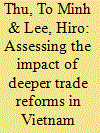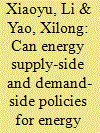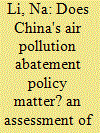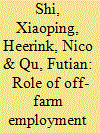|
|
|
Sort Order |
|
|
|
Items / Page
|
|
|
|
|
|
|
| Srl | Item |
| 1 |
ID:
138141


|
|
|
|
|
| Summary/Abstract |
Vietnam is currently undertaking deeper trade liberalization, both by reducing tariffs and introducing reforms in other trade-related areas. In this paper, the impact of Vietnam’s trade reforms on its economic welfare and sectoral adjustments are assessed using a dynamic computable general equilibrium (CGE) model. We consider the effects of goods and services trade liberalization, an increase in foreign direct investment inflows, a reduction in administrative and technical barriers to trade, and a reduction in trade and transport margins. When all effects are combined, Vietnam’s economic welfare is projected to increase by 8.4 per cent in 2020 compared to the baseline. Many manufacturing sectors would expand, whereas agricultural, minerals and fuel sectors would contract. The output expansion is most significant in the textiles and wearing apparel sector.
|
|
|
|
|
|
|
|
|
|
|
|
|
|
|
|
| 2 |
ID:
128045


|
|
|
|
|
| Publication |
2014.
|
| Summary/Abstract |
The 2009 Renewable Energies Directive (RED) has set up ambitious targets concerning biofuel consumption in the European Union by 2020. Nevertheless, budgetary constraints and growing concerns about the environmental integrity of first-generation biofuels have imposed a phasing out of the fiscal instruments to promote them. Focusing on France, this paper combines an exogenous increase in oil prices and tax policies on fossil fuels. The objective is to determine the efficiency of an alternative incentive scheme for biodiesel consumption based on a higher price of the fossil fuel substitute. Policy simulations are implemented through a dynamic computable general equilibrium (CGE) model calibrated on 2009 French data. The results show that the 10% biodiesel mandate set by the RED would not be achieved even if the fixed taxes on diesel reach the same level as those on gasoline. Although integrating the rise in oil prices into the fiscal framework improves the biodiesel penetration rate, it remains below the target. Moreover, we find that the effects of biofuel consumption are limited to the biofuel chain sectors. In other agricultural sectors, the substitution effect of biodiesel with diesel is partially offset by the pricing effect induced by higher energy production costs.
|
|
|
|
|
|
|
|
|
|
|
|
|
|
|
|
| 3 |
ID:
171511


|
|
|
|
|
| Summary/Abstract |
Existing literature mainly focuses on the combined effect of different policies on energy, economy and environment. However, most of them were based on the perspective of energy demand-side. In order to fill this gap, we study the effect of carbon tax and coal capacity cut from both the energy demand-side and energy supply-side using a dynamic Computable General Equilibrium (CGE) model. Different policy effects including single one and synergistic one are compared. Moreover, the synergy degrees of coal capacity cut and carbon tax in energy saving, emission reduction and economic growth are evaluated. The results show that both coal capacity cut and carbon tax are beneficial to energy conservation and carbon emission mitigation at the expense of a slight loss in economy. Mixed policy has better performance than single policy in carbon emission reduction and energy saving. Also, a more stringent policy is conducive to carbon emission mitigation and energy conservation. Additionally, there are significant synergistic effect of coal capacity cut and carbon tax from the perspectives of energy saving, emission reduction and economic growth. Therefore, the mixed policy of coal capacity cut and carbon tax should be promoted and an appropriate stringency level of policy mix should be adopted.
|
|
|
|
|
|
|
|
|
|
|
|
|
|
|
|
| 4 |
ID:
115691


|
|
|
|
|
| Publication |
2012.
|
| Summary/Abstract |
This paper examines the effectiveness of China's indigenous R&D and technological innovation to curb its carbon emissions. The mechanism of endogenous technical change (TC) is incorporated an intertemporal computable general equilibrium (CGE) model. R&D investments and knowledge creations are modeled as the endogenous behaviors of private firms. The accumulated stocks of knowledge are applied in the production process to affect the rate and bias of TC. Simulation results show that: (1) while China's indigenous R&D efforts play a significant role to curb carbon emissions, sole dependence on R&D may be far from sufficient to achieve pledged climate target, with complementary policies being required to reinforce existing climate actions; (2) innovation policies can strengthen R&D investment and cut emissions further, but the complementary effect is relatively minor; (3) carbon taxation can generate significant carbon-saving benefits and fulfill climate target, but this achievement is at the cost of economic losses. The induced technical improvement, however, can partially mitigate the deadweight loss incurred by carbon tax distortion.
|
|
|
|
|
|
|
|
|
|
|
|
|
|
|
|
| 5 |
ID:
177364


|
|
|
|
|
| Summary/Abstract |
Carbon policies differentiated according to regional disparities have been recognized and recommended. However, the air quality co-benefits of differentiated policies remain unclear. Here we combine a multi-regional dynamic computable general equilibrium (CGE) model and an extend response surface model (ERSM) to investigate the impact of nationally uniform and subnationally differentiated carbon pricing policies on fine particulate matter (PM2.5) concentrations in China. All policies examined lead to the same accumulated national CO2 emissions (2020–2050), with the 2030 emissions attaining China's national abatement target. We find that, when subnational policies differentiated according to provincial PM2.5 concentrations are implemented, the higher-than-average carbon price over more polluted provinces results in twice as much reduction in CO2 and air pollutant emissions in 2050 as the national policy. As a result, the subnational policies cause larger PM2.5 concentration reductions in these provinces (9%–18%) than the national policy (7%–11%). Also, the subnational policies eliminate high PM2.5 exposure of over 45 μg/m3 which 12% people suffer from under the national policy. The subnational policies substantially reduce regional disparity in PM2.5 pollution and hence improve environmental equity. The results suggest that subnationally differentiated carbon policies are a promising instrument to mitigate severe pollution and promote environmental equity.
|
|
|
|
|
|
|
|
|
|
|
|
|
|
|
|
| 6 |
ID:
166329


|
|
|
|
|
| Summary/Abstract |
This paper assesses the impact of China's air pollution abatement (APA) policies on both the economy and environment in the Beijing-Tianjin-Hebei (BTH) area, using a multi-regional energy-environment-economy computable general equilibrium (CGE) model incorporating the direct abatement expenditure of the proposed policies.
|
|
|
|
|
|
|
|
|
|
|
|
|
|
|
|
| 7 |
ID:
110500


|
|
|
|
|
| Publication |
2011.
|
| Summary/Abstract |
This study examines the conventional wisdom that off-farm employment contributes to environmental pollution by increasing the use of agro-chemicals. In order to analyse the role of household decision making and village factor markets in more detail, we run simulations with a hybrid farm household/village computable general equilibrium model that is applied to a village in Northeast Jiangxi Province. We find that the negative lost-labour effect of off-farm employment on agricultural incomes is much stronger than the (small) positive income effect. As a result of reduced labour resources and increased leisure consumption, farm households reduce the intensity of rice cultivation as well as the production of (especially) cash crops. The shift in production activities is stronger for migration than for off-farm employment, because migrants cannot combine off-farm work with onfarm work, and because migration reduces the village market price of oxen services. The shift towards less intensive rice production means that off-farm employment (and migration in particular) reduces the levels of chemical inputs and manure used in agricultural production. The decline in fertilizer input is much larger than the decline in manure use, because manure is a nontradable commodity and is applied only once per year. We therefore conclude that migration and, to a lesser extent, local off-farm employment lead to lower incomes from agricultural production, but have benign effects on environmental quality.
|
|
|
|
|
|
|
|
|
|
|
|
|
|
|
|
| 8 |
ID:
166304


|
|
|
|
|
| Summary/Abstract |
Energy efficient lighting confers significant potential in electricity demand reduction. To increase the diffusion of energy efficient lighting, an LED Replacement Lamps Program is proposed. Free of charge LED lamps are suggested to be distributed to households by government to reduce household electricity demand. Because electricity is heavily subsidized in Iran, the direct benefit of the program for the government will be avoiding the energy subsidy payments. Back-of-the-envelope benefit cost analysis suggests that if potential electricity savings are realized, the program will be profitable. However, the possible rebound effect may negatively impact the program effectiveness through partially offsetting the potential electricity savings. Therefore, the viability of the program depends on the actual electricity savings that may differ from its anticipated levels. A hybrid dynamic general equilibrium model is employed to evaluate the actual economy-wide energy savings. The model has the novelty of endogenously calculating useful energy demand (e.g. lighting, cooling). Energy demand is then derived based on end-use efficiency and useful energy demand. Model results indicate an average economy-wide rebound of 43.8%. Even though the rebound value is high, the program is shown to be profitable.
|
|
|
|
|
|
|
|
|
|
|
|
|
|
|
|
| 9 |
ID:
107494


|
|
|
|
|
| Publication |
2011.
|
| Summary/Abstract |
Fossil energy subsidies reform would be an effective way to improve the energy consumption structure; however, the reform needs to be assessed comprehensively beforehand as it would exert uncertain impacts on economy, society and environment. In this paper, we use price-gap approach to estimate the fossil energy subsidies of China, then establish CGE model that contains pollutant emissions accounts and CO2 emissions account to stimulate the fossil energy subsidies reform under different scenarios, and the environmental economic analysis concept is introduced to monetize the pollutant reduction benefits. Furthermore, we analyze the possibility and scope of improving the energy consumption structure from the perspective of technical and economic analysis. Analytical results show that the energy consumption structure could be improved by different extent by removing coal or oil subsidies, while the economic and social indexes will be influenced distinctively. Meanwhile, the effects of cutting coal subsidies are more feasible than that of cutting oil subsidies overall. It is recommended to implement fossil energy subsidies gradually, cut the coal first and then cut oil subsidies successively.
|
|
|
|
|
|
|
|
|
|
|
|
|
|
|
|
| 10 |
ID:
119829


|
|
|
|
|
| Publication |
2013.
|
| Summary/Abstract |
Given the rising price of crude oil, some developing countries including Thailand are looking towards developing their domestic renewable energy resources, in particular biofuels. However, there are concerns about the possible adverse effects such a policy strategy would have on key variables such as sectoral output, land allocation and the effects of prices, particularly food prices. This study develops a computable general equilibrium (CGE) model of the Thailand economy that features enhancements of the energy sector and uses it to analyze the government's recent renewable energy development plan. This plan aims to increase domestic energy use from renewable sources to replace fossil fuel imports. The study simulated specific policies contained in the plan. Among other things, we found that promoting biofuel use causes a rapid increase in the price of biofuel and biofuel feedstock in the short-run, whereas these prices only increase slightly in the long-run due to more elastic supplies. The prices of food and other products marginally increase, implying that food security is not undermined by the policy. On the basis of the findings, the study recommends a review of some of the targets because they were found to be rather high, and a phasing in of others.
|
|
|
|
|
|
|
|
|
|
|
|
|
|
|
|
| 11 |
ID:
086263


|
|
|
|
|
| Publication |
2009.
|
| Summary/Abstract |
This paper examines the peace dividend effect of Turkish convergence to EU membership. By employing a multi-region dynamic CGE model, we examine the prospect for conflict resolution if Turkey becomes an EU member. The model allows us to analyse several scenarios that imply varying amounts of reduction of the military expenditure/GDP ratios. On the one hand, this change will cause a decrease in sectoral demand for military expenditures, while on the other hand, reallocation of the reduced expenditure on (i) education, (ii) tax decrease, and (iii) infrastructure, should have a huge growth impact. Our dynamic CGE simulation experiments emphasize the economic gain for all parties involved.
|
|
|
|
|
|
|
|
|
|
|
|
|
|
|
|
| 12 |
ID:
089579


|
|
|
|
|
| Publication |
2009.
|
| Summary/Abstract |
Energy consumption in rural areas in China is characterized by high consumption of fuelwood, straw and other biomass. Off-farm employment can play an important role in the transition towards more sustainable sources of energy by increasing rural household incomes and reducing the amount of labor available for biomass collection. The purpose of this paper is to examine the impact of off-farm employment on rural household energy consumption choices, and to disentangle the various causal relationships that play a role in this respect. To this end, a hybrid farm household/village computable general equilibrium (CGE) model is used that has been calibrated for a remote village in Northeast Jiangxi Province where fuelwood is the main source of energy. The model takes into account nonseparability of farm household production and consumption decisions as well as linkages within the village between households involved in off-farm employment and households with no members working off-farm. Contrary to previous research for a richer region in rural China, we find that fuelwood is not an inferior good. The positive impact of more food consumption on fuelwood collection more than compensates the higher leisure demand associated with higher incomes. Shifts in production activities and in prices on village factor markets caused by increased labour scarcity (the lost-labour effect of off-farm employment), on the other hand, cause a reduction in fuelwood collection and consumption. This lost-labour effect is much stronger for migration than for local off-farm employment, because the latter can more easily be combined with on-farm work and fuelwood collection. For local off-farm employment the income effect dominates the lost-labour effect, resulting in a positive overall impact of higher off-farm participation on fuelwood consumption. For migration, on the other hand, the income effect and the lost-labour effect are almost equal in size. Hence, the amount of fuelwood collected and consumed does not change much when households participate in migration. The final conclusion is therefore that increased off-farm employment opportunities do not promote the transition of rural energy use in the poorer regions of rural China.
|
|
|
|
|
|
|
|
|
|
|
|
|
|
|
|
| 13 |
ID:
162323


|
|
|
|
|
| Summary/Abstract |
A unified policy framework for energy and water would be beneficial considering the high interdependence of the two resources in China. In this paper, a recursive dynamic computable general equilibrium model is established to examine the existence of synergetic effects within water fee policy and energy related climate policy, i.e. carbon tax, and provide insights for Chinese integrative policy-making. The results show that water fee can contribute to industrial water conservation, whereas its effect is limited under current water fee level. The adoption of a carbon tax in addition to it might further improve its water saving benefits. Furthermore, water fee can also promote the enhancement of China's emission reduction goal, and a higher carbon tax and water fee rate can achieve greater emission reduction effects. At this point, the synergetic spillover effects that water conservation benefits will be achieved simultaneously via the transition of industry into a more low-carbon form is critical for elaborating an effective strategy of environmental policy. Besides, our results suggest that giving priority to renewable power is regarded as the silver bullet to address the water and emission constraints on energy system, as it can optimize the water conservation benefits of emission reduction.
|
|
|
|
|
|
|
|
|
|
|
|
|
|
|
|
|
|
|
|
|